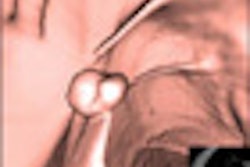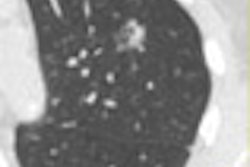Virtual colonoscopy is a valuable screening tool in symptomatic individuals age 70 and older, yielding diagnostic benefits far beyond the scope of barium enema exams, which remain common in the U.K. due to staffing and equipment issues, researchers report in this month's American Journal of Roentgenology.
In a study of 400 consecutive patients (average age, 79.6 years; range, 70-96 years; 62.5% female) with symptoms indicating an elevated risk of colorectal cancer, contrast-enhanced virtual colonoscopy (VC or CT colonography [CTC]) not only found a high prevalence of colon cancers, but also extracolonic malignancies in nearly 6% of patients.
"CTC findings yield a high number of new significant extracolonic abnormalities," the authors wrote. "This finding makes a compelling case for targeting this group of patients for a CTC service."
Virtual colonoscopy has replaced the barium enema in many U.K. healthcare facilities, owing to its safety, superior sensitivity, and ability to detect extracolonic abnormalities, wrote Drs. Damian Tolan, Euan Armstrong, and Anthony Chapman from St. James's University Hospital in Leeds and Derriford Hospital in Plymouth.
"CTC is well-tolerated in comparison with colonoscopy and barium enema, and is a safe technique; a recent United Kingdom survey by Burling and colleagues recorded adverse events in 0.08% of symptomatic patients undergoing CTC, with no deaths, and symptomatic perforations in 0.03%." they wrote. "CTC requires less patient movement than barium enema, which is a particular advantage in elderly patients or infirm patients" (AJR, November 2007, Vol. 189:5, pp. 1104-1111).
The researchers noted that in many U.K. hospitals a lack of equipment and trained staff has left barium enema as the primary investigation for patients with lower gastrointestinal symptoms.
"At our institution, after decommissioning a fluoroscopy room and using that space to house a new MDCT scanner, all patients older than 70 years referred for imaging because of lower gastrointestinal symptoms had CTC performed if fit for bowel cleansing," the group wrote. The patients were referred for various symptoms, particularly weight loss, a change in bowel habits, rectal blood loss, abdominal pain, or anemia.
All underwent virtual colonoscopy on either a four- or 16-slice MDCT scanner. Bowel preparation before scanning consisted of either sodium picosulphate plus magnesium citrate (Picolax, Nordic, Feltham, U.K.), or polyethylene glycol for those with impaired renal function or mild congestive cardiac failure (Kleen-Prep, Norgine, Oxford, U.K.). Automated colonic insufflation was performed with CO2 (ProtoCO2l, E-Z-EM, Lake Success, NY), and supine data were acquired 45 seconds after the administration of IV contrast material.
Prone and supine scans were acquired at 2.5-mm (four-slice MDCT) or 1-mm (16-slice MDCT) reconstructed slice thickness at 120 kVp and a minimum of 100 mAs using an automated dose-reduction technique.
The four experienced radiologists had each interpreted more than 1,000 datasets before the retrospective VC data evaluation began, and had completed a European Society of Gastrointestinal and Abdominal Radiology (ESGAR) training course. They read the images on a Leonardo workstation (Siemens Medical Solutions, Erlangen, Germany).
In all, the group detected 505 extracolonic abnormalities in 268 of the 400 (67%) patients, of which 139 in 116 patients were deemed significant. "Forty-nine of the 400 patients (12.3%) had at least one malignancy, including 23 extracolonic malignancies and 29 colorectal malignancies," Tolan and colleagues wrote.
Histology was not obtained in five patients, including four with unequivocal extensive metastatic disease and one who was too ill to undergo further investigation. Colorectal adenocarcinoma was confirmed in 24 of 29 patients with colonoscopic or surgical histologic correlation. One patient had prostate carcinoma invading to the rectum, and two had large severely dysplastic tubulovillous adenomas.
Thirteen patients had early (T1N0M0 or T2N0M0) cancers, and 20 of 29 colon cancer patients had significant previously unknown extracolonic abnormalities, "half of which were related to the primary tumor and half of which were unrelated extracolonic abnormalities," the authors reported. Overall there were 52 cancers in 49 patients, and 13 (26.5%) of these patients had early-stage tumors.
"If the cases of prostate cancer, carcinoid, and large tubulovillous adenoma are counted as false positives and if the patient diagnosed as too sick for follow-up is excluded, the sensitivity per patient for colorectal adenocarcinoma in our group is 84.8% (28/33)," the team wrote. "This sensitivity rises to 97% (32/33) when all significant malignancies of or involving the colon and large, severely dysplastic tubulovillous adenomas are included."
Significant extracolonic abnormalities were detected in 29% of patients, and 24% had previously unknown significant lesions. "This is more than twice as high as a pooled analysis of previous studies by Xiong and colleagues," Tolan and colleagues noted. "This discrepancy may be explained by the inclusion of asymptomatic populations in their meta-analysis, that most studies included did not use IV contrast material, and that the average patient age was substantially lower than that of our group."
For the elderly population, some have advocated minimal preparation VC, which allows the detection of extracolonic abnormalities and some significant colorectal lesions. However, "the positive predictive value for a diagnosis of colon cancer, at approximately 50%, is disappointing," the authors noted, and in this scenario 50% of patients may therefore require a subsequent workup with full prep even following the confident detection of an abnormality in minimal prep CTC.
"CTC and minimal preparation CT have clear advantages over colonoscopy and barium enema for the diagnosis and exclusion of extracolonic intra-abdominal abnormalities," they wrote. For those who can tolerate the prep, VC is therefore the better choice, though minimal prep VC "has an important role to play in the investigation of patients who are unfit to undergo bowel cleansing," the team wrote.
The studies main limitations included its retrospective design, and because all patients did not undergo full evaluation of their findings, their precise clinical impact is unknown, according to the authors. They expressed "frustration" over their inability to follow up some patients due to the study's retrospective design.
"In a growing elderly population, who have a higher incidence of significant extracolonic abnormalities, those who will tolerate bowel preparation are probably best served by undergoing an examination with the highest positive and negative predictive values, both for significant colonic and extracolonic abnormalities," the authors concluded.
By Eric Barnes
AuntMinnie.com staff writer
November 7, 2007
Related Reading
Significant extracolonic cancer found in VC screening patients, June 12, 2007
Extracolonic lesions: Find them if you can, October 30, 2006
Higher costs seen in post-VC extracolonic follow-up, November 3, 2006
Extracolonic findings double VC costs, but might be worth paying, July 20, 2006
Tagged VC succeeds where colonoscopy fails in elderly, March 28, 2006
Copyright © 2007 AuntMinnie.com



















